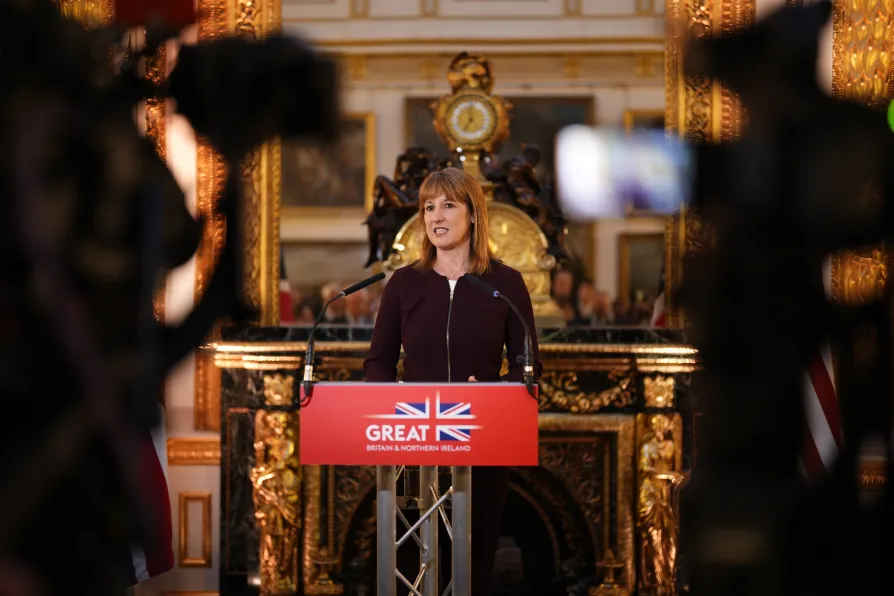The long-term effects of chemical weapons such as Agent Orange mean that the impact of war lasts well beyond a ceasefire
Error message
An error occurred while searching, try again later.It is the private sector’s failure of investment that is driving the economic crisis – Labour needs to realise that it’s the public sector that holds the key to getting the country back on track, argues MICHAEL BURKE

 WEDDED TO AUSTERITY ECONOMICS: Chancellor of the Exchequer Rachel Reeves speaks at a business reception in central London as part of US President Donald Trump’s state visit, September 18 2025
WEDDED TO AUSTERITY ECONOMICS: Chancellor of the Exchequer Rachel Reeves speaks at a business reception in central London as part of US President Donald Trump’s state visit, September 18 2025
THE government’s growth strategy lies in tatters. Or, more precisely, the flimsiness of the government strategy for growth has been completely exposed by the structural malaise of the British economy, global economic headwinds and Donald Trump.
But what it clear is that the government does not have a viable strategy to boost growth and needs one urgently.
The latest reminders of the weakness of the economy come from a variety of sources, tepid GDP data, falling numbers of people in work, declining housebuilding and forecasts of further economic stagnation and persistent inflation in Britain, coming from the Organisation for Economic Co-operation and Development (OECD).
All of this provides a grim backdrop ahead of the Budget in November. There is no shortage of advice for the Chancellor, which is overwhelmingly focused on whether her response should be mainly spending cuts (especially welfare) and or primarily tax increases, with most media commentators unsurprisingly insisting that these should fall on ordinary people, rather than those who actually have the capacity to pay higher taxes, big business and the ultra-wealthy.
From their perspective, it is as if the last 15 years of austerity have not happened and they have not failed to deliver either growth or even a sustained improvement in government finances.
Rachel Reeves has already implemented one austerity Budget where the biggest item was actually a stealth tax on workers by freezing income tax thresholds, a far bigger tax than the increase in employers’ National Insurance Contributions (NICs) that sparked so much furore. This was followed by a Spring Statement that cut welfare and a Spending Review which both cut public investment and diverted much of the remainder away from productive investment towards the military.
None of this has led to growth and government finances have deteriorated. This is exactly as the opponents of austerity said they would. If historical experience since 2010 is not enough, the Chancellor has already tried austerity for herself, and it has failed.
This is because cuts do not equal government savings. Every welfare cut has a consequence for health, which is reflected on the pressure on the NHS. Every cut to local authority spending cuts jobs and puts pressure on a string of other government budgets.
Every cut to public investment represents infrastructure jobs foregone and slower growth as firms struggle to deliver goods or services.
Essentially, the advocates of austerity are looking at symptoms, not causes. Unfortunately, the supporters of austerity clearly include this government.
Government finances are in a mess, that is without question. When the interest paid on government debt reaches of £110 billion a year and accounts for one in every 12 pounds the government spends, there is unquestionably a debt problem.
We should also note that these huge sums completely contradict all assertions that “the government can just print money.” It can, but to issue it as debt means interest must also be paid on it. If anyone believes that buyers of government bonds will simply accept it when that money too is just printed, they should ask Argentina’s Javier Milei if that works, or indeed Britain’s own Liz Truss.
But the government’s response to this crisis is to repeat the failed austerity policy. Recently, a small group of eminent economists, including for Bank of England chief economist Andy Haldane, Professor Mariana Mazzucato and others, wrote to the Chancellor arguing for a change of course on economic policy.
It included these remarks: “The only route to fiscal sustainability lies in finding a more sustainable growth model for the economy as a whole. This will not be achieved without a significant further increase in public investment.”
This is based on the correct assessment that weak government finances are a symptom of weak economic growth, and it is the latter which must be tackled. It then also correctly argues that public investment is crucial, and that it should rise significantly.
Why public investment? In a country like Britain public investment accounts for less than 2 per cent of GDP, whereas the private sector accounts for 16 per cent of GDP and consumption (by households, business and the government) accounts for 70 per cent.
Yet the eminent economists are right on this too. Consumption is not an input into growth and therefore cannot sustainably lead it. Consumption occurs after production, of goods or services.
When Joe Biden boosted consumption in the US after lockdowns ended, but without increasing the capacity to produce, all that happened was a global wave of inflation began that made people worse off.
Investment is decisive for growth. But once again the well-known economists are right. The private sector has refused to increase its investment despite all sorts of tax breaks, subsidies, tax cuts and admonishments. Under this government, the entire growth strategy has been built on hope this will end, with a particular focus on construction of homes to kick-start the economy.
There were just 113,000 housing starts in the financial year ending in April 2025, the lowest for 11 years.
This is an ongoing crisis of the private sector since the global financial crisis which dovetails with a key aspect of the long-term decline of the British economy. It is this private-sector failure of investment which is the driver of the crisis.
That is why the role of public-sector investment becomes decisive, because not only could the public sector raise the overall level of investment, but it would create conditions for a rise in private-sector investment too.
When the public sector builds homes — something it did not do at all in the last fiscal year — it forces an army of private sector suppliers and workers into the homebuilding business to support it. The same is true across large swathes of the economy.
There is no question of government not being able to borrow for investment under current circumstances. Markets are always ing to lend when there is a return on investment, which is the very definition of investment.
It is also true that no sensible fiscal rules have ever blocked public investment, precisely because it leads to economic growth and so improves government finances. Unfortunately, Rachel Reeves’s fiscal rules did make that major mistake and Jeremy Hunt’s were even worse, restricting total government spending, including investment.
A change of government policy is strongly endorsed by leading economists and would be a sensible alternative. But this government does not want to change course. It seems wedded to the failed ideologies of Osborne and Cameron, and before them Thatcher. Until it is forced to change course, by one means or another, we will pay the price for their failure.










